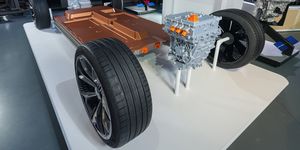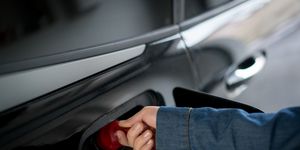- The chief strategist at Volkswagen says vehicle-to-grid technology will open up new business opportunities for the automaker.
- Cars that support the technology can store excess power and sell it back to the electrical grid in times of need.
- The Nissan Leaf already supports this technology, but the feature also needs to be supported by the charger.
Volkswagen’s transition to electrification continues to yield business opportunities, according to its chief strategist, Michael Jost. In addition to vehicle sales, it has the growing Electrify America charging network, and now it looks like the company is planning to use the batteries in the cars it sells to help power the electrical grid.
In an interview quoted by Reuters, Jost said: “By 2025 we will have 350 gigawatt-hours worth of energy storage at our disposal through our electric-car fleet. Between 2025 and 2030, this will grow to one terawatt-hour’s worth of storage.” He added that it’s more power than what’s generated by all the “hydroelectric power stations in the world.”
What Jost didn’t share is which upcoming EVs from Volkswagen will support this feature, or if the company’s ID.Charger station (pictured at top) will support bilateral charging. Currently, the Nissan Leaf and the Mitsubishi Outlander are the only vehicles on the market that support sharing power from their batteries back to the grid, and even if you have one of those vehicles, your home charger has to support bilateral charging where it allows energy both to the battery and back to the grid.
What Volkswagen is promising could not only help the automaker and people who own its EVs generate some extra cash; it could be part of the ongoing evolution currently taking place with the electrical grid.
Previously, the electrical grid had no way to store extra power. If a power station was generating too much electricity, it was essentially wasting all that extra wattage. But if the power station can’t handle the electricity demand during a heat wave when a whole section of the country has the AC blasting, the utilities can spin up stations called “peakers” to come online to close the supply gap. They tend to be expensive, take a while to spin up, and typically are nowhere near as efficient as the rest of the grid.
The recent advances in battery technology that power EVs have also changed the grid landscape, specifically Tesla’s Powerpack battery storage solutions. The company has deployed these in Australia, Kauai, California, and other locations. These locations allow the extra power that solar and wind might produce but are not needed at the moment to be stored and then deployed either during times of heavy electricity usage or at night when the sun is down. In essence, they replace the traditional peakers in a more efficient way and allow renewable sources to generate as much power as possible.
What Volkswagen is talking about is creating a distributed power storage system. Tesla’s Powerpack stations are great, but if they’re knocked off line by an accident or natural disaster like a fire, that could disrupt the grid when it’s needed most. By making every EV a storage solution, if something happens in a geographic area, it won’t stop the rest of the batteries out there feeding the grid.
For Volkswagen, it could be a source of income that we assume they would share with their customers since the company wants to use their EVs as a power source. But it’s not such a stretch to picture other automakers supporting vehicle-to-grid charging in the future and giving us all a chance to create a cleaner and more robust grid while making some money on the side.
Source: Motor - aranddriver.com










